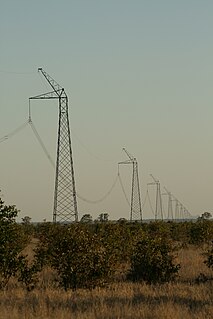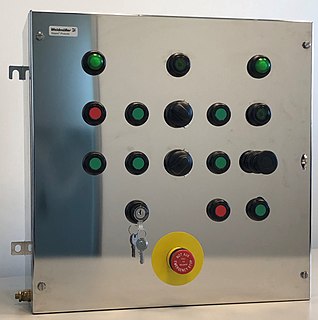A bonding jumper is a reliable conductor to ensure the required electrical conductivity between metal raceways required to be electrically connected. [1]
Contents

A bonding jumper is a reliable conductor to ensure the required electrical conductivity between metal raceways required to be electrically connected. [1]

"Bonding" is a method by which all electrically conductive materials and metallic surfaces of equipment and structures, not normally intended to be energized, are effectively connected with a low impedance path to avoid any appreciable potential difference between any separate points. Bonding ensures that all surfaces accessible to a person are at the same potential, reducing the hazard of an electric shock. A bonded system is not necessarily connected to earth, for example, in an aircraft.
The common way to effectively bond different metallic surfaces of enclosures, electrical equipment, pipes, tubes or structures together is with a copper conductor, rated lugs and appropriate bolts, fasteners or screws. Other bonding means between different metallic parts and pieces might employ brackets, clamps, exothermic bonds or welds to make effective connections.
Effectively bonded equipment can also safely conduct phase-to-ground fault currents, induced currents, surge currents, lightning currents or transient currents during abnormal conditions. Bonding jumpers must be sized to safely handle the anticipated fault current.
Rules for bonding jumper installation are given in electrical code regulations. Typically, these require a jumper at any place where the continuity of a bonding system might be interrupted, for example, where metallic conduits join an enclosure through fittings that do not assure good electrical contact. [2] Some codes require a bonding jumper to be pulled into non-metallic conduit or in electrical metallic tubing that may be exposed to corrosion or mechanical damage.
In North American electrical codes, an important bonding jumper is found in main electrical panels, where the system neutral conductor is connected to earth ground. This must be done at only one point in each separately derived system to prevent flow of objectionable current in the earth.
Bonding jumpers may be installed wherever metal parts are free to move on a hinge or bearing. This is done for electrical safety grounding, static electricity protection, and may also be useful for control of electromagnetic interference. For example, a control panel door may have a bonding jumper across the hinges so that the metal door is effectively connected to ground, since the hinges may not provide a reliable contact.
Temporary bonding jumpers are used in the handling of flammable liquids and gases, so that static charge on a vehicle or portable tank does not ignite escaping gas.

In electrical engineering, ground or earth is the reference point in an electrical circuit from which voltages are measured, a common return path for electric current, or a direct physical connection to the earth.

A substation is a part of an electrical generation, transmission, and distribution system. Substations transform voltage from high to low, or the reverse, or perform any of several other important functions. Between the generating station and consumer, electric power may flow through several substations at different voltage levels. A substation may include transformers to change voltage levels between high transmission voltages and lower distribution voltages, or at the interconnection of two different transmission voltages.

Single-wire earth return (SWER) or single-wire ground return is a single-wire transmission line which supplies single-phase electric power from an electrical grid to remote areas at low cost. Its distinguishing feature is that the earth is used as the return path for the current, to avoid the need for a second wire to act as a return path.
Electrical wiring in North America follows regulations and standards for installation of building wiring which ultimately provides mains electricity.

A residual-current device (RCD), residual-current circuit breaker (RCCB), or ground-fault circuit interrupter (GFCI) is a device that quickly breaks an electrical circuit to prevent serious harm from an ongoing electric shock. Injury may still occur in some cases, for example if a human falls after receiving a shock, or if the person touches both conductors at the same time which an RCD won't prevent.

An Earth-leakage circuit breaker (ELCB) is a safety device used in electrical installations with high Earth impedance to prevent shock. It detects small stray voltages on the metal enclosures of electrical equipment, and interrupts the circuit if a dangerous voltage is detected. Once widely used, more recent installations instead use residual-current devices which instead detect leakage current directly.
In the electrical appliance manufacturing industry, the following IEC protection classes are defined in IEC 61140 and used to differentiate between the protective-earth connection requirements of devices.
As the neutral point of an electrical supply system is often connected to earth ground, ground and neutral are closely related. Under certain conditions, a conductor used to connect to a system neutral is also used for grounding (earthing) of equipment and structures. Current carried on a grounding conductor can result in objectionable or dangerous voltages appearing on equipment enclosures, so the installation of grounding conductors and neutral conductors is carefully defined in electrical regulations. Where a neutral conductor is used also to connect equipment enclosures to earth, care must be taken that the neutral conductor never rises to a high voltage with respect to local ground.

Electrical wiring is an electrical installation of cabling and associated devices such as switches, distribution boards, sockets, and light fittings in a structure.
Electrical wiring in the United Kingdom is commonly understood to be an electrical installation for operation by end users within domestic, commercial, industrial, and other buildings, and also in special installations and locations, such as marinas or caravan parks. It does not normally cover the transmission or distribution of electricity to them.
An earthing system (UK) or grounding system (US) connects specific parts of an electric power system with the ground, typically the Earth's conductive surface, for safety and functional purposes. The choice of earthing system can affect the safety and electromagnetic compatibility of the installation. Regulations for earthing systems vary considerably among countries, though most follow the recommendations of the International Electrotechnical Commission. Regulations may identify special cases for earthing in mines, in patient care areas, or in hazardous areas of industrial plants.

An electrical enclosure is a cabinet for electrical or electronic equipment to mount switches, knobs and displays and to prevent electrical shock to equipment users and protect the contents from the environment. The enclosure is the only part of the equipment which is seen by users. It may be designed not only for its utilitarian requirements, but also to be pleasing to the eye. Regulations may dictate the features and performance of enclosures for electrical equipment in hazardous areas, such as petrochemical plants or coal mines. Electronic packaging may place many demands on an enclosure for heat dissipation, radio frequency interference and electrostatic discharge protection, as well as functional, esthetic and commercial constraints.
Electrical bonding is the practice of intentionally electrically connecting all exposed metal items not designed to carry electricity in a room or building as protection from electric shock. If a failure of electrical insulation occurs, all bonded metal objects in the room will have substantially the same electrical potential, so that an occupant of the room cannot touch two objects with significantly different potentials. Even if the connection to a distant earth ground is lost, the occupant will be protected from dangerous potential differences.
In an electric power system, a fault or fault current is any abnormal electric current. For example, a short circuit is a fault in which current bypasses the normal load. An open-circuit fault occurs if a circuit is interrupted by some failure. In three-phase systems, a fault may involve one or more phases and ground, or may occur only between phases. In a "ground fault" or "earth fault", current flows into the earth. The prospective short-circuit current of a predictable fault can be calculated for most situations. In power systems, protective devices can detect fault conditions and operate circuit breakers and other devices to limit the loss of service due to a failure.

In electrical engineering, earth potential rise (EPR) also called ground potential rise (GPR) occurs when a large current flows to earth through an earth grid impedance. The potential relative to a distant point on the Earth is highest at the point where current enters the ground, and declines with distance from the source. Ground potential rise is a concern in the design of electrical substations because the high potential may be a hazard to people or equipment.

Stray voltage is the occurrence of electrical potential between two objects that ideally should not have any voltage difference between them. Small voltages often exist between two grounded objects in separate locations, due to normal current flow in the power system. Large voltages can appear on the enclosures of electrical equipment due to a fault in the electrical power system, such as a failure of insulation.
Electrical safety testing is essential to ensure safe operating standards for any product that uses electricity. Various governments and agencies have developed stringent requirements for electrical products that are sold world-wide. In most markets it is mandatory for a product to conform to safety standards promulgated by safety and standard agencies such as UL, VDE, CSA, BSI and so on. To conform to such standards, the product must pass safety tests such as the high voltage test, Insulation Resistance Test, Ground (Earth) Bond and Ground Continuity Test and Leakage Current Test. These tests are described in IEC 60335, IEC 61010 and many other national and international standards.
An isolated ground (IG) is a ground connection to a local earth electrode from equipment where the main supply uses a different earthing arrangement, one of the common earthing arrangements used with domestic mains supplies. It is distinct from a TT earthing system where the system electrode is also part of the safety earthing and not neutral bonded. In most countries where regulation permits it, TT is preferred for such systems as conventional wiring techniques can be used. Examples where an IG may be required include radio transmitters where it is not desired for RF currents associated with the antenna and its earthing to enter the mains supply wiring, and in reverse, for sensitive apparatus that should be protected from supply borne interference. Great care has to be taken to maintain system safety with such systems, and each case has to be carefully considered.
In building wiring installed with separate neutral and protective ground bonding conductors, a bootleg ground is a connection between the neutral side of a receptacle or light fixture and the ground lug or enclosure of the wiring device. This connects the neutral side of the receptacle to the casing of an appliance or lamp. It can be a hazard because the neutral wire is a current-carrying conductor, which means the casing can become energized. In addition, a fault condition to a bootleg ground will not trip a GFCI breaker or receptacle that is wired from the load side of a GFCI receptacle.

An electrical conduit is a tube used to protect and route electrical wiring in a building or structure. Electrical conduit may be made of metal, plastic, fiber, or fired clay. Most conduit is rigid, but flexible conduit is used for some purposes.